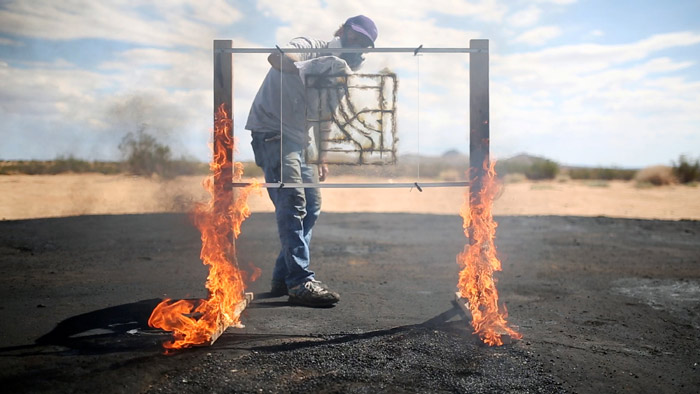A recent Facebook comment on the artistic validity of a social practice project made a snarky case that war could too be considered art, due to its impact and sublime scale. If one took up this misguided thought experiment, then an elaborating context could be the rhetoric of Italian Futurists. As they posited, the tools of war have the potential to morph from weapons to medium. This is what Jesse Sugarmann has done for his second solo exhibition, California City, at Fourteen 30 Contemporary in Portland, Oregon.
The title of the exhibition is taken from California’s third largest city, calculated by square miles. Its history and characteristics mirror many faded southwest towns. Real estate speculators bet on the water coming, which it has yet to do, leaving parched pavement to be reclaimed by the sands. The vast emptiness of California City’s forty square miles have been a beacon to off-road vehicle enthusiasts, bonfire parties, and weapon testing from Edwards Air Force base. The results of this ongoing history became the jumping off point for the works in this show: two videos and five works of napalm on acrylic, all from 2013,titled California Bloodlines.
Sugarmann’s past works have deftly engaged with the history of the automotive industry and the legacy of quirky visual culture it has generated. In sculptures involving mini-vans, windscreens, and beaded car seat covers, he has assembled attractive visual jokes, which monumentalize these ubiquitous ready-made materials. These works notably include videos and performances of vehicles on collision courses set in motion by fork-lifts and air mattresses where Sugarmann has slowed down the moment of action into an anticlimactic theatricality, allowing one to ponder the aesthetics within the moment of a split-second car accident. In California City he both continues his work within auto industry and deviates from it.
In the five-minute video California Bloodlines (GPS dozen) a driver attempts to navigate what remains of the streets in a California City neighborhood with the assistance of twelve GPS devices. The many computerized voices synchronize and dissonate with one and other, advising the driver to make turns on streets like California Boulevard, a barely visible trace where sand and sage brush have taken over. A choir of “recalculating” is called out again and again as the driver aimlessly wanders.
Where Sugarmann veers off from the car culture are a series of map-like drawings depicting tracks of land found in this too-big-to-fail town. These images are lined out in napalm on 24-inch square of acrylic and then lit on fire. The acrylic is thick enough not to warp under the heat, but the burning ooze does melt away and bubble up the plastic, leaving a brown scar upon the surface defined by the black smudges of the smoke. Napalm is a mixture of a viscous material and gasoline. Its sticky quality is what makes it so deadly and why it was chosen by the US military and the artist to be used as a mark maker. Napalm’s origins track back to the Second World War, but its almost pop-culture reputation comes from its extensive use in Vietnam, which coincides with California City’s incorporation in 1965.
The burnt and smoky quality of the drawings leave one with a haunted feeling, while their fiery origin and abstracted nature posses an air of early 20th century modernist occult, and bring to mind the strange bed fellows of rocket scientist Jack Parsons and mystic Aleister Crowley. These references to rituals are reinforced by the ultra crisp video playing in the back room of the gallery, California Bloodlines (parts 1 and 2).
Unfolding over thirty minutes total, the first and shorter part of the video depicts a man and woman in matching faded denim and gray T-shirt sweeping and painting with mops on a stretch of sand covered road. Within the cast space, they push around and paint the shell of an open wheeled dragster.
The second part of the video unveils some of the production of the napalm drawings. A sheet of acrylic is hung between a frame of lumber, the napalm has already been laid out, the camera is in front of the plastic, looking through to the desert, and soon the napalm is lit. The camera captures with incredible detail the flame that emerges and quickly spreads over the drawing, leaving a demonic smoke that soon blackens the entire work. We watch it burn and bubble until the artist decides that it has done enough damage, he extinguishes the fire with splash and then washes the piece with soap and water, wiping away the smudges that he can, leaving the work as we see it in the gallery.
In one of the final scenes of the video, the legs of the wooden structure holding the drawing are on fire and we see Sugermann wearing a respirator as he is wiping away at the drawing. The theatrics of this moment recall the 1950 Hans Namuth film of Jackson Pollock working on clear surfaces. It is a reveal of process, an elevation of stature, and a wickedly powerful image of the artist playing with fire. In it he is the artist conjurer, not in the way Marinetti wrote, “about the love of danger, about the use of energy, and recklessness as common daily practice” but rather a taming of the weapon. Sugarmann turns them around in order to create theory object rather than instruments of war.
Mack McFarland is an artist and curator at the Pacific Northwest College of Art’s Philip Feldman Gallery + Project Space in Portland, OR.
























